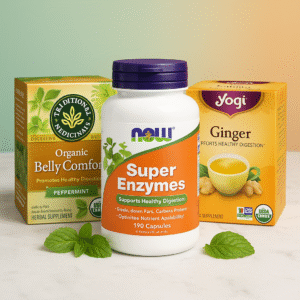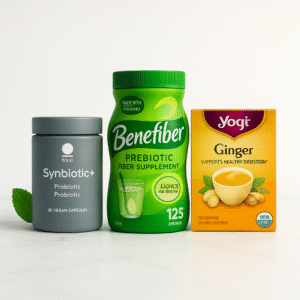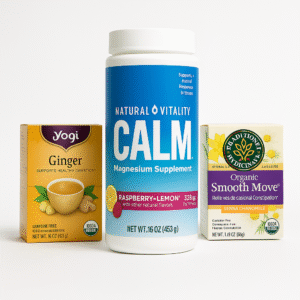Gut-Skin Axis: The Probiotic Connection You Need to Know
Explore the gut-skin axis and the role of probiotics in enhancing skin health. Uncover the science behind this vital connection for a revitalized skincare approach.

Recent research reveals a connection between gut health and skin conditions or gut-skin axis.
Probiotics, known to maintain gut balance, can also enhance skin health by reducing inflammation, oxidative stress, and strengthening immunity.
This article delves into how probiotics potentially revolutionize skincare.
Key Points
- Probiotics in Skincare: Probiotics, beneficial microorganisms, are emerging as potential heroes in skincare. Historically used for skin issues like acne, they now address multiple skin concerns without the toxicity seen in some cosmetics.
- Gut-Skin Axis: The intricate relationship between the gut and skin emphasizes the profound impact of internal probiotics. Consumed supplements influence skin health through gut balance, highlighting the gut-skin axis.
- Probiotics and Skin Disorders: Probiotics have shown promise in managing various skin disorders, including acne, atopic dermatitis, psoriasis, seborrheic dermatitis, and rosacea. Both oral and topical applications have been explored for their potential benefits.
- Gut Microbiome and Skin Immunity: The gut microbiome plays a pivotal role in skin immunity. Certain gut microbes produce compounds that encourage anti-inflammatory reactions, while others regulate immune cell behavior, affecting skin health.
- Neuroendocrine Link: The skin and gastrointestinal lining communicate via neuroendocrine signaling. This connection influences various skin conditions and emphasizes the importance of maintaining a balanced microbiota in both the gut and skin for optimal health.
In This Article:
Introduction
Skin covers a vast 1.5-2 m2 area of an adult body, playing pivotal roles like protecting against harmful microorganisms, conserving body water, and aiding in vitamin synthesis A Trusted Source Sender R., Fuchs S., Milo R. Revised estimates for the number of human and bacteria cells in the body. PLoS Biol. 2016;14:e1002533. doi: 10.1371/journal.pbio.1002533. [PMC free article] [PubMed] [CrossRef] [Google Scholar] PLoS Biol. PMC free article PubMed CrossRef Google Scholar A Trusted Source Grice E.A., Segre J.A. The skin microbiome. Nat. Rev. Microbiol. 2011;9:244–253. doi: 10.1038/nrmicro2537. [PMC free article] [PubMed] [CrossRef] [Google Scholar] Nat. Rev. Microbiol. PMC free article PubMed CrossRef Google Scholar A Trusted Source Oh J., Byrd A.L., Park M., Kong H.H., Segre J.A. Temporal stability of the human skin microbiome. Cell. 2016;165:854–866. doi: 10.1016/j.cell.2016.04.008. [PMC free article] [PubMed] [CrossRef] [Google Scholar] Cell. PMC free article PubMed CrossRef Google Scholar A Trusted Source Schommer N.N., Gallo R.L. Structure and function of the human skin microbiome. Trends Microbiol. 2013;21:660–668. doi: 10.1016/j.tim.2013.10.001. [PMC free article] [PubMed] [CrossRef] [Google Scholar] Trends Microbiol. PMC free article PubMed CrossRef Google Scholar .
Today's pursuit of beauty often grapples with challenges like wrinkles, pigmentation, and aging. Traditional cosmetics contain chemicals like titanium dioxide, which can have health implications A Trusted Source Dréno B., Alexis A., Chuberre B., Marinovich M. Safety of titanium dioxide nanoparticles in cosmetics. J. Eur. Acad. Dermatol. Venereol. 2019;33:34–46. doi: 10.1111/jdv.15943. [PubMed] [CrossRef] [Google Scholar] J. Eur. Acad. Dermatol. Venereol. PubMed CrossRef Google Scholar .
While herbal ingredients show promise, their inconsistent results warrant the search for better solutions A Trusted Source Hu Y., Zeng H., Huang J., Jiang L., Chen J., Zeng Q. Traditional Asian aerbs in skin whitening: The current development and limitations. Front. Pharmacol. 2020;11:982. doi: 10.3389/fphar.2020.00982. [PMC free article] [PubMed] [CrossRef] [Google Scholar] Front. Pharmacol. PMC free article PubMed CrossRef Google Scholar A Trusted Source Yu J., Ma X., Wang X., Cui X., Ding K., Wang S., Han C. Application and mechanism of probiotics in skin care: A review. J. Cosmet. Dermatol. 2022;21:886–894. doi: 10.1111/jocd.14734. [PubMed] [CrossRef] [Google Scholar] J. Cosmet. Dermatol. PubMed CrossRef Google Scholar .
Enter probiotics: these beneficial microorganisms are emerging as potential skincare heroes.
Researchers believe they can address multiple skin concerns without the toxicity seen in some cosmetics.
In fact, probiotics' influence on skincare isn't new.
Lactobacillus bulgaricus was topically applied as early as 1912 for skin issues like acne A Trusted Source Puebla-Barragan S., Reid G. Probiotics in cosmetic and personal care products: Trends and challenges. Molecules. 2021;26:1249. doi: 10.3390/molecules26051249. [PMC free article] [PubMed] [CrossRef] [Google Scholar] Molecules. PMC free article PubMed CrossRef Google Scholar .
The modern skincare market is booming with probiotic-laden products.
However, challenges exist: ensuring these products remain sterile, the viability of probiotic strains in the presence of antiseptics, and meeting the USFDA's stringent standards A Trusted Source Osborne D., Tan P., Varma Y., Carbol J. Formulating topical products containing live microorganisms as the active ingredient. Pharm. Technol. 2018;42:32–36. [Google Scholar] Pharm. Technol. Google Scholar.
A major hurdle is the skin's own protective barrier, the stratum corneum, which dictates how much of any applied product penetrates deeper layers A Trusted Source Marto J., Ascenso A., Simoes S., Almeida A.J., Ribeiro H.M. Pickering emulsions: Challenges and opportunities in topical delivery. Expert. Opin. Drug Deliv. 2016;13:1093–1107. doi: 10.1080/17425247.2016.1182489. [PubMed] [CrossRef] [Google Scholar] Expert. Opin. Drug Deliv. PubMed CrossRef Google Scholar.
Products containing live microorganisms need specific conditions for microbial stability, including pH and temperature controls A Trusted Source Sreeja V., Prajapati J.B. Probiotic formulations: Application and status as pharmaceuticals-a review. Probiotics Antimicrob. Proteins. 2013;5:81–91. doi: 10.1007/s12602-013-9126-2. [PubMed] [CrossRef] [Google Scholar] Probiotics Antimicrob. Proteins. PubMed CrossRef Google Scholar .
While topical probiotics have a long history, the past decade has seen a surge in their commercial availability A Trusted Source Lee G.R., Maarouf M., Hendricks A.J., Lee D.E., Shi V.Y. Topical probiotics: The unknowns behind their rising popularity. Dermatol. Online J. 2019;25:15–21. doi: 10.5070/D3255044062. [PubMed] [CrossRef] [Google Scholar] Dermatol. Online J. PubMed CrossRef Google Scholar .
However, the real excitement lies in internal probiotics—consumed supplements that influence skin health through gut balance. This underscores the profound connection between the gut, probiotics, and skin health, offering hope for innovative skin treatments.

Probiotics on the Skin
Probiotics: A New Age Solution to Skin Brightening
Skin lightening is an ever-growing trend, aiming to reduce melanin, which can sometimes lead to disorders like freckles and melasma A Trusted Source Pillaiyar T., Manickam M., Jung S.H. Recent development of signaling pathways inhibitors of melanogenesis. Cell. Signal. 2017;40:99–115. doi: 10.1016/j.cellsig.2017.09.004. [PubMed] [CrossRef] [Google Scholar] Cell. Signal. PubMed CrossRef Google Scholar A Trusted Source Brenner M., Hearing V.J. The protective role of melanin against UV damage in human skin. Photochem. Photobiol. 2008;84:539–549. doi: 10.1111/j.1751-1097.2007.00226.x. [PMC free article] [PubMed] [CrossRef] [Google Scholar] Photochem. Photobiol. PMC free article PubMed CrossRef Google Scholar A Trusted Source Iozumi K., Hoganson G.E., Pennella R., Everett M.A., Fuller B.B. Role of tyrosinase as the determinant of pigmentation in cultured human melanocytes. J. Investig. Dermatol. 1993;100:806–811. doi: 10.1111/1523-1747.ep12476630. [PubMed] [CrossRef] [Google Scholar] J. Investig. Dermatol. PubMed CrossRef Google Scholar A Trusted SourceLi G., Ju H.K., Chang H.W., Jahng Y., Lee S.H., Son J.K. Melanin biosynthesis inhibitors from the bark of Machilus thunbergii. Biol. Pharm. Bull. 2003;26:1039–1041. doi: 10.1248/bpb.26.1039. [PubMed] [CrossRef] [Google Scholar] Biol. Pharm. Bull. PubMed CrossRef Google Scholar.
Melanin production involves enzymes, notably tyrosinase, which is vital for melanin synthesis A Trusted Source Pillaiyar T., Manickam M., Jung S.H. Inhibitors of melanogenesis: A patent review (2009–2014) Expert. Opin. Ther. Pat. 2015;25:775–788. doi: 10.1517/13543776.2015.1039985. [PubMed] [CrossRef] [Google Scholar] Expert. Opin. Ther. Pat. PubMed CrossRef Google Scholar A Trusted Source Schiaffino M.V. Signaling pathways in melanosome biogenesis and pathology. Int. J. Biochem. Cell Biol. 2010;42:1094–1104. doi: 10.1016/j.biocel.2010.03.023. [PMC free article] [PubMed] [CrossRef] [Google Scholar] Int. J. Biochem. Cell Biol. PMC free article PubMed CrossRef Google Scholar A Trusted Source Pillaiyar T., Manickam M., Namasivayam V. Skin whitening agents: Medicinal chemistry perspective of tyrosinase inhibitors. J. Enzym. Inhib. Med. Chem. 2017;32:403–425. doi: 10.1080/14756366.2016.1256882. [PMC free article] [PubMed] [CrossRef] [Google Scholar] J. Enzym. Inhib. Med. Chem. PMC free article PubMed CrossRef Google Scholar.
Many cosmetics target tyrosinase to achieve brightening effects.
Notably, probiotics, known for gut health, are now gaining traction in skin brightening due to their ability to counteract tyrosinase A Trusted Source Huang H.C., Chang T.M. Antioxidative properties and inhibitory effect of Bifidobacterium adolescentis on melanogenesis. World J. Microbiol. Biotechnol. 2012;28:2903–2912. doi: 10.1007/s11274-012-1096-0. [PubMed] [CrossRef] [Google Scholar] World J. Microbiol. Biotechnol. PubMed CrossRef Google Scholar.
For instance, Bifidobacterium adolescentis reduces melanin in cells by inhibiting tyrosinase through its antioxidant properties.
Lactic acid in Lactobacillus further hinders melanin synthesis, targeting tyrosinase and related enzymes A Trusted Source Huang H.C., Lee I.J., Huang C., Chang T.M. Lactic acid bacteria and lactic acid for skin health and melanogenesis inhibition. Curr. Pharm. Biotechnol. 2020;21:566–577. doi: 10.2174/1389201021666200109104701. [PubMed] [CrossRef] [Google Scholar] Curr. Pharm. Biotechnol. PubMed CrossRef Google Scholar.
Beyond direct enzyme inhibition, other mechanisms also play a role.
Lactobacillus helveticus, for instance, not only suppresses tyrosinase but also improves skin pigmentation by regulating Nrf2 activity, crucial for melanogenesis under UV stress A Trusted Source Lim H.Y., Jeong D., Park S.H., Shin K.K., Hong Y.H., Kim E., Yu Y.G., Kim T.R., Kim H., Lee J., et al. Antiwrinkle and antimelanogenesis effects of tyndallized Lactobacillus acidophilus KCCM12625P. Int. J. Mol. Sci. 2020;21:1620. doi: 10.3390/ijms21051620. [PMC free article] [PubMed] [CrossRef] [Google Scholar] Int. J. Mol. Sci. PMC free article PubMed CrossRef Google Scholar A Trusted Source Chaiprasongsuk A., Onkoksoong T., Pluemsamran T., Limsaengurai S., Panich U. Photoprotection by dietary phenolics against melanogenesis induced by UVA through Nrf2-dependent antioxidant responses. Redox Biol. 2016;8:79–90. doi: 10.1016/j.redox.2015.12.006. [PMC free article] [PubMed] [CrossRef] [Google Scholar] Redox Biol. PMC free article PubMed CrossRef Google Scholar .
Rhodobacter spheroides is another promising agent, demonstrating reduced melanin synthesis in specific conditions A Trusted Source Liu W.S., Kuan Y.D., Chiu K.H., Wang W.K., Chang F.H., Liu C.H., Lee C.H. The extract of Rhodobacter sphaeroides inhibits melanogenesis through the MEK/ERK signaling pathway. Mar. Drugs. 2013;11:1899–1908. doi: 10.3390/md11061899. [PMC free article] [PubMed] [CrossRef] [Google Scholar] Mar. Drugs. PMC free article PubMed CrossRef Google Scholar .
In summary, probiotics offer a multifaceted approach to skin brightening, making them an exciting frontier in skincare.
Unlocking Probiotics: The Future of Skin Hydration
Dry skin can be influenced by various factors including season changes and damaged skin barriers A Trusted Source Kim H., Kim J.T., Barua S., Yoo S.Y., Hong S.C., Lee K.B., Lee J. Seeking better topical delivery technologies of moisturizing agents for enhanced skin moisturization. Expert. Opin. Drug Deliv. 2018;15:17–31. doi: 10.1080/17425247.2017.1306054. [PubMed] [CrossRef] [Google Scholar] Expert. Opin. Drug Deliv. PubMed CrossRef Google Scholar .
Hydrated skin is crucial for overall health and appearance.
Recent research highlights probiotics as promising agents in enhancing skin hydration. They can not only reduce trans-epidermal water loss (TEWL) but also amplify the skin's barrier function A Trusted Source Harding C.R., Watkinson A., Rawlings A.V., Scott I.R. Dry skin, moisturization and corneodesmolysis. Int. J. Cosmet. Sci. 2000;22:21–52. doi: 10.1046/j.1467-2494.2000.00001.x. [PubMed] [CrossRef] [Google Scholar] Int. J. Cosmet. Sci. PubMed CrossRef Google Scholar .
Lactobacillus plantarum HY7714, for instance, has been observed to boost ceramide levels, crucial for maintaining skin hydration A Trusted Source Ra J., Lee D.E., Kim S.H., Jeong J.W., Ku H.K., Kim T.Y., Choi I.D., Jeung W., Sim J.H., Ahn Y.T. Effect of oral administration of Lactobacillus plantarum HY7714 on epidermal hydration in ultraviolet B-irradiated hairless mice. J. Microbiol. Biotechnol. 2014;24:1736–1743. doi: 10.4014/jmb.1408.08023. [PubMed] [CrossRef] [Google Scholar] J. Microbiol. Biotechnol. PubMed CrossRef Google Scholar A Trusted Source Elias P.M., Menon G.K. Structural and lipid biochemical correlates of the epidermal permeability barrier. Adv. Lipid Res. 1991;24:1–26. [PubMed] [Google Scholar] Adv. Lipid Res. PubMed Google Scholar A Trusted Source Holleran W.M., Uchida Y., Halkier-Sorensen L., Haratake A., Hara M., Epstein J.H., Elias P.M. Structural and biochemical basis for the UVB-induced alterations in epidermal barrier function. Photodermatol. Photoimmunol. Photomed. 1997;13:117–128. doi: 10.1111/j.1600-0781.1997.tb00214.x. [PubMed] [CrossRef] [Google Scholar] Photodermatol. Photoimmunol. Photomed. PubMed CrossRef Google Scholar.
Another study revealed that Lactobacillus acidophilus IDCC 3302 significantly improved skin dryness and hydration A Trusted Source Im A.R., Lee B., Kang D.J., Chae S. Skin moisturizing and antiphotodamage effects of tyndallized Lactobacillus acidophilus IDCC 3302. J. Med. Food. 2018;21:1016–1023. doi: 10.1089/jmf.2017.4100. [PubMed] [CrossRef] [Google Scholar] J. Med. Food. PubMed CrossRef Google Scholar A Trusted Source Papakonstantinou E., Roth M., Karakiulakis G. Hyaluronic acid: A key molecule in skin aging. Derm.-Endocrinol. 2012;4:253–258. doi: 10.4161/derm.21923. [PMC free article] [PubMed] [CrossRef] [Google Scholar] Derm.-Endocrinol. PMC free article PubMed CrossRef Google Scholar .
Moreover, Lactobacillus helveticus-fermented milk whey demonstrated potential in enhancing skin moisture content A Trusted Source Baba H., Masuyama A., Yoshimura C., Aoyama Y., Takano T., Ohki K. Oral intake of Lactobacillus helveticus-fermented milk whey decreased transepidermal water loss and prevented the onset of sodium dodecylsulfate-induced dermatitis in mice. Biosci. Biotechnol. Biochem. 2010;74:18–23. doi: 10.1271/bbb.90370. [PubMed] [CrossRef] [Google Scholar] Biosci. Biotechnol. Biochem. PubMed CrossRef Google Scholar.
In essence, probiotics are emerging as potent skin hydration, offering a fresh avenue in skincare.
Boosting Skin Barrier with Probiotics
A strong skin barrier is essential for maintaining skin's moisture balance A Trusted Source Segre J.A. Epidermal barrier formation and recovery in skin disorders. J. Clin. Investig. 2006;116:1150–1158. doi: 10.1172/JCI28521. [PMC free article] [PubMed] [CrossRef] [Google Scholar] J. Clin. Investig. PMC free article PubMed CrossRef Google Scholar.
Research by Ye-On Jung and team revealed that Lactobacillus rhamnosus (LR) enhances skin barrier function A Trusted Source Jung Y.O., Jeong H., Cho Y., Lee E.O., Jang H.W., Kim J., Nam K., Lim K.M. Lysates of a probiotic, Lactobacillus rhamnosus, can improve skin barrier function in a reconstructed human epidermis model. Int. J. Mol. Sci. 2019;20:4289. doi: 10.3390/ijms20174289. [PMC free article] [PubMed] [CrossRef] [Google Scholar] Int. J. Mol. Sci. PMC free article PubMed CrossRef Google Scholar.
This was evidenced by increased levels of barrier-strengthening molecules, Claudin-1 and Occludin A Trusted Source Draelos Z.D. New treatments for restoring impaired epidermal barrier permeability: Skin barrier repair creams. Clin. Dermatol. 2012;30:345–348. doi: 10.1016/j.clindermatol.2011.08.018. [PubMed] [CrossRef] [Google Scholar] Clin. Dermatol. PubMed CrossRef Google Scholar.
Additionally, treatments with LR lysate displayed an organized stratum corneum and resilience against harmful agents like sodium dodecyl sulfate (SLS).
Probiotics in Anti-Aging
Skin ages through two main processes: chronological aging, driven by internal factors, and photoaging, affected by external factors A Trusted Source Cho S. The role of functional foods in cutaneous anti-aging. J. Lifestyle Med. 2014;4:8–16. doi: 10.15280/jlm.2014.4.1.8. [PMC free article] [PubMed] [CrossRef] [Google Scholar] J. Lifestyle Med. PMC free article PubMed CrossRef Google Scholar .
While distinct, they share regulatory mechanisms. Probiotics beneficially impact both aging types A Trusted Source Trojahn C., Dobos G., Lichterfeld A., Blume-Peytavi U., Kottner J. Characterizing facial skin ageing in humans: Disentangling extrinsic from intrinsic biological phenomena. Biomed Res. Int. 2015;2015:318586. doi: 10.1155/2015/318586. [PMC free article] [PubMed] [CrossRef] [Google Scholar] Biomed Res. Int. PMC free article PubMed CrossRef Google Scholar .
Anti-Aging with Probiotics
Chronological aging is a natural process driven by genetics, leading to skin thinning and dryness A Trusted Source Mora Huertas A.C., Schmelzer C.E., Hoehenwarter W., Heyroth F., Heinz A. Molecular-level insights into aging processes of skin elastin. Biochimie. 2016;128–129:163–173. doi: 10.1016/j.biochi.2016.08.010. [PubMed] [CrossRef] [Google Scholar] Biochimie. PubMed CrossRef Google Scholar.
Probiotics counteract aging by reducing cell decay and extending the cell cycle. Notably, Sphingomonas hydrophobicum (SH) extraction diminishes aging-associated proteins P16 and P21 A Trusted Source Gervason S., Napoli M., Dreux-Zhiga A., Lazzarelli C., Garcier S., Briand A., Albouy M., Thepot A., Berthon J.Y., Filaire E. Attenuation of negative effects of senescence in human skin using an extract from Sphingomonas hydrophobicum: Development of new skin care solution. Int. J. Cosmet. Sci. 2019;41:391–397. [PubMed] [Google Scholar] Int. J. Cosmet. Sci. PubMed Google Scholar A Trusted Source Dolan D.W., Zupanic A., Nelson G., Hall P., Miwa S., Kirkwood T.B., Shanley D.P. Integrated stochastic model of DNA damage repair by non-homologous end joining and p53/p21-mediated early senescence signalling. PLoS Comput. Biol. 2015;11:e1004246. doi: 10.1371/journal.pcbi.1004246. [PMC free article] [PubMed] [CrossRef] [Google Scholar] PLoS Comput. Biol. PMC free article PubMed CrossRef Google Scholar, which slow cell cycles.
Tests showed lowered P16 and P21 levels with SH than without.
Additionally, SH lessens SA-β-galactosidase linked to aging, enhances fibrillin-1 responsible for elastic skin fibers A Trusted Source Penner A.S., Rock M.J., Kielty C.M., Shipley J.M. Microfibril-associated glycoprotein-2 interacts with fibrillin-1 and fibrillin-2 suggesting a role for MAGP-2 in elastic fiber assembly. J. Biol. Chem. 2002;277:35044–35049. doi: 10.1074/jbc.M206363200. [PubMed] [CrossRef] [Google Scholar] J. Biol. Chem. PubMed CrossRef Google Scholar, and boosts Versican which curbs fibroblast apoptosis A Trusted Source Sheng W., Wang G., Wang Y., Liang J., Wen J., Zheng P.S., Wu Y., Lee V., Slingerland J., Dumont D., et al. The roles of versican V1 and V2 isoforms in cell proliferation and apoptosis. Mol. Biol. Cell. 2005;16:1330–1340. doi: 10.1091/mbc.e04-04-0295. [PMC free article] [PubMed] [CrossRef] [Google Scholar] Mol. Biol. Cell. PMC free article PubMed CrossRef Google Scholar.
Thus, SH extraction presents promise as an anti-aging skincare solution.
Probiotics: The Shield Against Photoaging
Photoaging, driven by external factors like UV radiation, makes skin lose elasticity and moisture, turning it coarse and dull A Trusted Source Fisher G.J., Kang S., Varani J., Bata-Csorgo Z., Wan Y., Datta S., Voorhees J.J. Mechanisms of photoaging and chronological skin aging. Arch. Dermatol. 2002;138:1462–1470. doi: 10.1001/archderm.138.11.1462. [PubMed] [CrossRef] [Google Scholar] Arch. Dermatol. PubMed CrossRef Google Scholar.
Probiotics counteract this by curbing collagen degradation.
Specifically, Lactobacillus plantarum HY7714 users experienced enhanced skin elasticity, moisture retention, and reduced wrinkles A Trusted Source Lee D.E., Huh C.S., Ra J., Choi I.D., Jeong J.W., Kim S.H., Ryu J.H., Seo Y.K., Koh J.S., Lee J.H., et al. Clinical evidence of effects of Lactobacillus plantarum HY7714 on skin aging: A randomized, double blind, placebo-controlled study. J. Microbiol. Biotechnol. 2015;25:2160–2168. doi: 10.4014/jmb.1509.09021. [PubMed] [CrossRef] [Google Scholar] J. Microbiol. Biotechnol. PubMed CrossRef Google Scholar .
Moreover, tyndallized Lactobacillus acidophilus IDCC 3302 restored collagen lost to UV exposure and curbed harmful UV-induced enzymes and inflammatory agents A Trusted Source Im A.R., Lee B., Kang D.J., Chae S. Protective effects of tyndallized Lactobacillus acidophilus IDCC 3302 against UVB-induced photodamage to epidermal keratinocytes cells. Int. J. Mol. Med. 2019;43:2499–2506. doi: 10.3892/ijmm.2019.4161. [PubMed] [CrossRef] [Google Scholar] Int. J. Mol. Med. PubMed CrossRef Google Scholar .
Research by You et al. found Lactobacillus sakei Lipoteichoic Acid (sLTA) inhibited skin damage processes when exposed to UV rays A Trusted Source You G.E., Jung B.J., Kim H.R., Kim H.G., Kim T.R., Chung D.K. Lactobacillus sakeilipoteichoic acid inhibits MMP-1 induced by UVA in normal dermal fibroblasts of human. J. Microbiol. Biotechnol. 2013;23:1357–1364. doi: 10.4014/jmb.1306.06026. [PubMed] [CrossRef] [Google Scholar] J. Microbiol. Biotechnol. PubMed CrossRef Google Scholar.
Probiotics: The Answer to Wrinkle Reduction
Wrinkles, resulting from skin atrophy and facial muscle contractions A Trusted SourceSmall R. Botulinum toxin injection for facial wrinkles. Am. Fam. Physician. 2014;90:168–175. [PubMed] [Google Scholar] Am. Fam. Physician. PubMed Google Scholar , can be mitigated with probiotics.
These beneficial microbes combat wrinkles by their antioxidant properties and inhibition of MMP-1, a molecule that breaks down skin's collagen A Trusted Source Park S.H., Lee K.H., Han C.S., Kim K.H., Kim Y.H. Inhibitory effects of carex humilis extract on elastase activity and matrix metalloproteinase-1 expression. J. Soc. Cosmet. Sci. Korea. 2010;36:129–136. [Google Scholar] J. Soc. Cosmet. Sci. Korea. Google Scholar.
Tyndallized Lactobacillus KCCM12625P (AL) specifically hinders MMP-1, reducing wrinkle formation.
Another strain, Lactobacillus plantarum HY7714, robustly blocks UV-induced MMP-1 A Trusted Source Kim H.M., Lee D.E., Park S.D., Kim Y.T., Kim Y.J., Jeong J.W., Jang S.S., Ahn Y.T., Sim J.H., Huh C.S., et al. Oral administration of Lactobacillus plantarum HY7714 protects hairless mouse against ultraviolet B induced photoaging. J. Microbiol. Biotechnol. 2014;24:1583–1591. doi: 10.4014/jmb.1406.06038. [PubMed] [CrossRef] [Google Scholar] J. Microbiol. Biotechnol. PubMed CrossRef Google Scholar, diminishing wrinkle area and depth.
Tyndallized Lactobacillus acidophilus IDCC 3302 further suppresses MMPs in UV-stressed cells, providing a wrinkle-reducing effect.
Gut-Skin Axis: Probiotics to the Rescue
The gut and skin share microbial similarities, and imbalances in the gut can lead to skin issues due to their interconnected nature A Trusted Source Szántó M., Dózsa A., Antal D., Szabó K., Kemény L., Bai P. Targeting the gut-skin axis-Probiotics as new tools for skin disorder management? Exp. Dermatol. 2019;28:1210–1218. doi: 10.1111/exd.14016. [PubMed] [CrossRef] [Google Scholar] Exp. Dermatol. PubMed CrossRef Google Scholar.

Imbalanced gut microbiota can spark inflammation not just in the intestines but also in distant organs like the skin, potentially contributing to conditions like acne A Trusted Source Bowe W.P., Filip J.C., DiRienzo J.M., Volgina A., Margolis D.J. Inhibition of propionibacterium acnes by bacteriocin-like inhibitory substances (BLIS) produced by Streptococcus salivarius. J. Drugs Dermatol. 2006;5:868–870. [PMC free article] [PubMed] [Google Scholar] J. Drugs Dermatol. PMC free article PubMed Google Scholar A Trusted Source Bowe W.P., Logan A.C. Acne vulgaris, probiotics and the gut-brain-skin axis-back to the future? Gut Pathog. 2011;3:1. doi: 10.1186/1757-4749-3-1. [PMC free article] [PubMed] [CrossRef] [Google Scholar] Gut Pathog. PMC free article PubMed CrossRef Google Scholar , atopic dermatitis A Trusted Source Kim B.J., Lee S.Y., Kim H.B., Lee E., Hong S.J. Environmental changes, microbiota, and allergic diseases. Allergy Asthma Immunol. Res. 2014;6:389–400. doi: 10.4168/aair.2014.6.5.389. [PMC free article] [PubMed] [CrossRef] [Google Scholar] Allergy Asthma Immunol. Res. PMC free article PubMed CrossRef Google Scholar , psoriasis A Trusted Source Hidalgo-Cantabrana C., Gómez J., Delgado S., Requena-López S., Queiro-Silva R., Margolles A., Coto E., Sánchez B., Coto-Segura P. Gut microbiota dysbiosis in a cohort of patients with psoriasis. Br. J. Dermatol. 2019;181:1287–1295. doi: 10.1111/bjd.17931. [PubMed] [CrossRef] [Google Scholar] Br. J. Dermatol. PubMed CrossRef Google Scholar , and rosacea A Trusted Source Nam J.H., Yun Y., Kim H.S., Kim H.N., Jung H.J., Chang Y., Ryu S., Shin H., Kim H.L., Kim W.S. Rosacea and its association with enteral microbiota in Korean females. Exp. Dermatol. 2018;27:37–42. doi: 10.1111/exd.13398. [PubMed] [CrossRef] [Google Scholar] Exp. Dermatol. PubMed CrossRef Google Scholar .
The immune system acts as the bridge connecting these two vital organs. A well-regulated interaction between microbes and the immune system ensures skin health A Trusted Source De Pessemier B., Grine L., Debaere M., Maes A., Paetzold B., Callewaert C. Gut-skin axis: Current knowledge of the interrelationship between microbial dysbiosis and skin conditions. Microorganisms. 2021;9:353. doi: 10.3390/microorganisms9020353. [PMC free article] [PubMed] [CrossRef] [Google Scholar] Microorganisms. PMC free article PubMed CrossRef Google Scholar .
Oral probiotics, living microbes that fine-tune the gut's environment, have shown promising effects against skin photoaging.
They provide photoprotection by modulating immune responses, curbing inflammation, and enhancing beneficial fatty acids in the serum.
Notably, their impact extends beyond just preventing aging; they also address skin conditions like acne and rosacea by adjusting the gut-skin balance A Trusted SourceD’Elios S., Trambusti I., Verduci E., Ferrante G., Rosati S., Marseglia G.L., Drago L., Peroni D.G. Probiotics in the prevention and treatment of atopic dermatitis. Pediatr. Allergy Immunol. 2020;31:43–45. doi: 10.1111/pai.13364. [PubMed] [CrossRef] [Google Scholar] Pediatr. Allergy Immunol. PubMed CrossRef Google Scholar A Trusted Source Habeebuddin M., Karnati R.K., Shiroorkar P.N., Nagaraja S., Asdaq S.M.B., Khalid Anwer M., Fattepur S. Topical probiotics: More than a skin deep. Pharmaceutics. 2022;14:557. doi: 10.3390/pharmaceutics14030557. [PMC free article] [PubMed] [CrossRef] [Google Scholar] Pharmaceutics. PMC free article PubMed CrossRef Google Scholar .
In essence, maintaining a healthy gut-skin axis through probiotics can be a game-changer in skincare.
Improvement of Intestinal Homeostasis by Probiotics
Boosting the Gut's Protective Wall with Probiotics
Probiotics play a crucial role in strengthening the gut barrier.
They enhance the production of mucin proteins like MUC1, MUC2, and MUC3, which limit bacterial movement in the mucus.
Additionally, probiotics boost the release and expression of protective substances such as α-defensins, β-defensins, and tight junction proteins like ZO.
These factors work together to fortify the gut barrier and prevent unwanted cell proliferation A Trusted Source Ohland C.L., Macnaughton W.K. Probiotic bacteria and intestinal epithelial barrier function. Am. J. Physiol. Gastrointest. Liver Physiol. 2010;298:G807–G819. doi: 10.1152/ajpgi.00243.2009. [PubMed] [CrossRef] [Google Scholar] Am. J. Physiol. Gastrointest. Liver Physiol. PubMed CrossRef Google Scholar .
Probiotics: Natural Defenders Against Pathogens
Probiotics counter harmful bacteria by binding to mucins or epithelial cells, halting their overgrowth.
They release anti-microbial agents, including SCFA and bacteriocins, which suppress or destroy these pathogens.
Crucially, SCFA, such as butyrate, enhance the epithelial barrier's strength by regulating proteins like occludin and ZO.
Additionally, probiotics amplify the production of IgA in the gut, which offers protection against potential invasions by binding to pathogens and reducing inflammation A Trusted Source Eslami M., Bahar A., Keikha M., Karbalaei M., Kobyliak N., Yousefi B. Probiotics function and modulation of the immune system in allergic diseases. Allergol. Immunopathol. 2020;48:771–788. doi: 10.1016/j.aller.2020.04.005. [PubMed] [CrossRef] [Google Scholar] Allergol. Immunopathol. PubMed CrossRef Google Scholar A Trusted Source Mantis N.J., Rol N., Corthésy B. Secretory IgA’s complex roles in immunity and mucosal homeostasis in the gut. Mucosal. Immunol. 2011;4:603–611. doi: 10.1038/mi.2011.41. [PMC free article] [PubMed] [CrossRef] [Google Scholar] Mucosal. Immunol. PMC free article PubMed CrossRef Google Scholar .
Gut Microbiome: A Key Player in Skin Immunity
There's an intricate connection between our gut and skin, especially when looking at Staphylococcus aureus, a prevalent bacterium affecting atopic dermatitis (AD).
Interestingly, while this bacterium is commonly found on AD-affected skin, early exposure to certain strains can fortify an infant's immune system, hinting at a protective role through immune stimulation A Trusted Source Yokoyama S., Hiramoto K., Koyama M., Ooi K. Impairment of skin barrier function via cholinergic signal transduction in a dextran sulphate sodium-induced colitis mouse model. Exp. Dermatol. 2015;24:779–784. doi: 10.1111/exd.12775. [PubMed] [CrossRef] [Google Scholar] Exp. Dermatol. PubMed CrossRef Google Scholar.
Certain gut microbes produce compounds like retinoic acid, which encourage anti-inflammatory reactions, while substances like butyrate regulate immune cell behavior A Trusted Source Salem I., Ramser A., Isham N., Ghannoum M.A. The gut microbiome as a major regulator of the gut-skin axis. Front. Microbiol. 2018;9:1459. doi: 10.3389/fmicb.2018.01459. [PMC free article] [PubMed] [CrossRef] [Google Scholar] Front. Microbiol. PMC free article PubMed CrossRef Google Scholar .
Probiotics, when consumed, interact profoundly with the gut's immune landscape.
Over 70% of our immune cells reside here A Trusted Source Lebeer S., Vanderleyden J., De Keersmaecker S.C. Host interactions of probiotic bacterial surface molecules: Comparison with commensals and pathogens. Nat. Rev. Microbiol. 2010;8:171–184. doi: 10.1038/nrmicro2297. [PubMed] [CrossRef] [Google Scholar] Nat. Rev. Microbiol. PubMed CrossRef Google Scholar .
Depending on the probiotic type, they can stimulate immune responses or foster tolerance by producing specific cytokines A Trusted Source Ueno N., Fujiya M., Segawa S., Nata T., Moriichi K., Tanabe H., Mizukami Y., Kobayashi N., Ito K., Kohgo Y. Heat-killed body of lactobacillus brevis SBC8803 ameliorates intestinal injury in a murine model of colitis by enhancing the intestinal barrier function. Inflamm. Bowel Dis. 2011;17:2235–2250. doi: 10.1002/ibd.21597. [PubMed] [CrossRef] [Google Scholar] Inflamm. Bowel Dis. PubMed CrossRef Google Scholar A Trusted Source Smits H.H., Engering A., van der Kleij D., de Jong E.C., Schipper K., van Capel T.M., Zaat B.A., Yazdanbakhsh M., Wierenga E.A., van Kooyk Y., et al. Selective probiotic bacteria induce IL-10-producing regulatory T cells in vitro by modulating dendritic cell function through dendritic cell-specific intercellular adhesion molecule 3-grabbing nonintegrin. J. Allergy Clin. Immunol. 2005;115:1260–1267. doi: 10.1016/j.jaci.2005.03.036. [PubMed] [CrossRef] [Google Scholar] J. Allergy Clin. Immunol. PubMed CrossRef Google Scholar .
This delicate balance, steered by probiotics, is crucial in managing the body's immune tolerance.
Moreover, early research suggests that variations in the gut's microbial composition, especially in infants with AD, could influence the development and function of the host's immune cells A Trusted Source Lee M.J., Kang M.J., Lee S.Y., Lee E., Kim K., Won S., Suh D.I., Kim K.W., Sheen Y.H., Ahn K., et al. Perturbations of gut microbiome genes in infants with atopic dermatitis according to feeding type. J. Allergy Clin. Immunol. 2018;141:1310–1319. doi: 10.1016/j.jaci.2017.11.045. [PubMed] [CrossRef] [Google Scholar] J. Allergy Clin. Immunol. PubMed CrossRef Google Scholar .
Gut Metabolites: Bridging Skin and Intestinal Health
The connection between our intestines and skin is profoundly influenced by specific metabolites from the gut's microbiota, like SCFAs.
These compounds, either naturally produced by gut microbes like Akkermansia muciniphila or introduced orally, play pivotal roles in atopic dermatitis (AD) and its link to the skin's immune system A Trusted Source Kaikiri H., Miyamoto J., Kawakami T., Park S.B., Kitamura N., Kishino S., Yonejima Y., Hisa K., Watanabe J., Ogita T., et al. Supplemental feeding of a gut microbial metabolite of linoleic acid, 10-Hydroxy-Cis-12-Octadecenoic acid, alleviates spontaneous atopic dermatitis and modulates intestinal microbiota in NC/Nga mice. Int. J. Food Sci. Nutr. 2017;68:941–951. doi: 10.1080/09637486.2017.1318116. [PubMed] [CrossRef] [Google Scholar] Int. J. Food Sci. Nutr. PubMed CrossRef Google Scholar.
Fascinatingly, certain metabolites, such as linoleic acid, have shown potential in managing AD and gut microbiota in animal studies.
Recent research unveiled three distinct neonatal gut microbiota subgroups (NGM1-3) which appear to influence early allergic reactions A Trusted Source Johnson A.M.F., DePaolo R.W. Window-of-opportunity: Neonatal gut microbiota and atopy. Hepatobiliary Surg. Nutr. 2017;6:190–192. doi: 10.21037/hbsn.2017.03.05. [PMC free article] [PubMed] [CrossRef] [Google Scholar] Hepatobiliary Surg. Nutr. PMC free article PubMed CrossRef Google Scholar .
Of particular interest is NGM3, connected to several allergies and notably lacking in certain bacteria.
One key metabolite, 12,13-DiHome, known for its inflammatory tendencies, is found abundantly in NGM3 and even present in the protective coating on newborn skin A Trusted Source Yokoyama S., Hiramoto K., Koyama M., Ooi K. Impairment of skin barrier function via cholinergic signal transduction in a dextran sulphate sodium-induced colitis mouse model. Exp. Dermatol. 2015;24:779–784. doi: 10.1111/exd.12775. [PubMed] [CrossRef] [Google Scholar] Exp. Dermatol. PubMed CrossRef Google Scholar .
This discovery suggests a potential metabolite pathway linking the gut and skin, underscoring the intricate relationships driving our health from the inside out.

Gut-Skin Connection: The Neuroendocrine Link
Both the skin and the gastrointestinal (GI) lining serve as barriers, guarding against harmful pathogens from the outside environment.
Maintaining a balanced microbiota in both organs is crucial for health, as these microbes aid in fending off harmful bacteria and play a role in immune functions.
Interestingly, these two microbiomes communicate via neuroendocrine signaling, either directly or indirectly.
For instance, gut microbes can produce tryptophan causing skin itchiness, while others produce γ-aminobutyric acid which alleviates itching A Trusted Source Jin U.H., Lee S.O., Sridharan G., Lee K., Davidson L.A., Jayaraman A., Chapkin R.S., Alaniz R., Safe S. Microbiome-derived tryptophan metabolites and their aryl hydrocarbon receptor-dependent agonist and antagonist activities. Mol. Pharmacol. 2014;85:777–788. doi: 10.1124/mol.113.091165. [PMC free article] [PubMed] [CrossRef] [Google Scholar] Mol. Pharmacol. PMC free article PubMed CrossRef Google Scholar .
Indirectly, certain gut microbes can influence brain function by altering blood cytokines, leading to stress and anxiety.
The stress hormone cortisol, in turn, can impact the intestinal barrier, and also modulate circulating neuroendocrine molecules, boosting skin barrier functions A Trusted Source Cryan J.F., Dinan T.G. Mind-altering microorganisms: The impact of the gut microbiota on brain and behaviour. Nat. Rev. Neurosci. 2012;13:701–712. doi: 10.1038/nrn3346. [PubMed] [CrossRef] [Google Scholar] Nat. Rev. Neurosci. PubMed CrossRef Google Scholar A Trusted Source Zipperer A., Konnerth M.C., Laux C., Berscheid A., Janek D., Weidenmaier C., Burian M., Schilling N.A., Slavetinsky C., Marschal M., et al. Human commensals producing a novel antibiotic impair pathogen colonization. Nature. 2016;535:511–516. doi: 10.1038/nature18634. [PubMed] [CrossRef] [Google Scholar] Nature. PubMed CrossRef Google Scholar .
Probiotics-Mediate Intestinal Microbiota to Improve Skin Disorders
Probiotics: A Game-Changer for Acne
Acne-affected skin has a unique microbial profile. Traditional treatments can damage the skin's natural barrier, causing dryness and irritation.
However, recent research suggests a promising role for probiotics in acne management.
Both oral and topical probiotics improve skin health by strengthening its mechanical barrier and boosting the immune response.
A notable example is the lactic acid bacterium, Streptococcus thermophiles, which, when applied topically, promotes ceramide synthesis A Trusted SourceDi Marzio L., Cinque B., Cupelli F., De Simone C., Cifone M.G., Giuliani M. Increase of skin-ceramide levels in aged subjects following a short-term topical application of bacterial sphingomyelinase from Streptococcus thermophilus. Int. J. Immunopathol. Pharmacol. 2008;21:137–143. doi: 10.1177/039463200802100115. [PubMed] [CrossRef] [Google Scholar] Int. J. Immunopathol. Pharmacol. PubMed CrossRef Google Scholar A Trusted SourceDi Marzio L., Centi C., Cinque B., Masci S., Giuliani M., Arcieri A., Zicari L., De Simone C., Cifone M.G. Effect of the lactic acid bacterium Streptococcus thermophilus on stratum corneum ceramide levels and signs and symptoms of atopic dermatitis patients. Exp. Dermatol. 2003;12:615–620. doi: 10.1034/j.1600-0625.2003.00051.x. [PubMed] [CrossRef] [Google Scholar] Exp. Dermatol. PubMed CrossRef Google Scholar.
These ceramides not only moisturize but also have antibacterial properties against acne-causing bacteria. Hence, probiotics can offer a multi-faceted approach to acne relief.
Probiotics: A Breakthrough for Atopic Dermatitis (AD)
Atopic Dermatitis, often linked to Staphylococcus aureus, stems from reduced microbial diversity.
Recent studies highlight the potential of oral probiotics as an effective AD treatment A Trusted Source Ambrożej D., Kunkiel K., Dumycz K., Feleszko W. The use of probiotics and bacteria-derived preparations in topical treatment of atopic dermatitis—A systematic review. J. Allergy Clin. Immunol. Pract. 2021;9:570–575. doi: 10.1016/j.jaip.2020.07.051. [PubMed] [CrossRef] [Google Scholar] J. Allergy Clin. Immunol. Pract. PubMed CrossRef Google Scholar .
For instance, Streptococcus thermophilus not only reduced AD-associated eczema but also eased symptom severity.
Moreover, it was found to boost skin ceramide levels, which are vital for skin health.
In experiments, emollients infused with Lactobacillus effectively curtailed Staphylococcus aureus, strengthened the skin barrier, and alleviated AD symptoms A Trusted SourcePark S.B., Im M., Lee Y., Lee J.H., Lim J., Park Y.H., Seo Y.J. Effect of emollients containing vegetable-derived lactobacillus in the treatment of atopic dermatitis symptoms: Split-body clinical trial. Ann. Dermatol. 2014;26:150–155. doi: 10.5021/ad.2014.26.2.150. [PMC free article] [PubMed] [CrossRef] [Google Scholar] Ann. Dermatol. PMC free article PubMed CrossRef Google Scholar.
Similarly, treatments with Roseomonas mucosa led to notable improvements in AD without any adverse effects A Trusted Source Myles I.A., Castillo C.R., Barbian K.D., Kanakabandi K., Virtaneva K., Fitzmeyer E., Paneru M., Otaizo-Carrasquero F., Myers T.G., Markowitz T.E., et al. Therapeutic responses to Roseomonas mucosa in atopic dermatitis may involve lipid-mediated TNF-related epithelial repair. Sci. Transl. Med. 2020;12:eaaz8631. doi: 10.1126/scitranslmed.aaz8631. [PMC free article] [PubMed] [CrossRef] [Google Scholar] Sci. Transl. Med. PMC free article PubMed CrossRef Google Scholar.
Overall, probiotics are emerging as a promising avenue for AD management.
Probiotics and Psoriasis: A New Perspective
Psoriasis, a chronic autoimmune skin condition, typically relies on emollients and oral immunosuppressants for treatment.
Some studies hint at the potential of topical probiotics in managing the condition, while others emphasize the possible benefits of oral probiotics in alleviating symptoms.
However, conclusive evidence about the efficacy of oral probiotics for psoriasis patients remains to be established.
Probiotics: A Solution for Seborrheic Dermatitis?
Seborrheic dermatitis, marked by dandruff and caused by yeast overgrowth and a reduced diversity of microbiota on the scalp, has been the focus of multiple studies exploring the potential of probiotics for treatment.
Some findings indicate the benefits of topical applications of filamentous Staphylococci, reducing symptoms like redness and flaking A Trusted SourceGuéniche A., Hennino A., Goujon C., Dahel K., Bastien P., Martin R., Jourdain R., Breton L. Improvement of atopic dermatitis skin symptoms by Vitreoscilla filiformis bacterial extract. Eur. J. Dermatol. EJD. 2006;16:380–384. [PubMed] [Google Scholar] Eur. J. Dermatol. EJD. PubMed Google Scholar .
Additionally, the use of Vitreoscilla filiformis lysate and Lactobacillus paracasei has shown promising results in managing the condition A Trusted SourceVolz T., Skabytska Y., Guenova E., Chen K.M., Frick J.S., Kirschning C.J., Kaesler S., Röcken M., Biedermann T. Nonpathogenic bacteria alleviating atopic dermatitis inflammation induce IL-10-producing dendritic cells and regulatory Tr1 cells. J. Investig. Dermatol. 2014;134:96–104. doi: 10.1038/jid.2013.291. [PubMed] [CrossRef] [Google Scholar] J. Investig. Dermatol. PubMed CrossRef Google Scholar A Trusted SourceReygagne P., Bastien P., Couavoux M.P., Philippe D., Renouf M., Castiel-Higounenc I., Gueniche A. The positive benefit of Lactobacillus paracasei NCC2461 ST11 in healthy volunteers with moderate to severe dandruff. Benef. Microbes. 2017;8:671–680. doi: 10.3920/BM2016.0144. [PubMed] [CrossRef] [Google Scholar] Benef. Microbes. PubMed CrossRef Google Scholar .
However, further research is essential to fully ascertain the local effectiveness of probiotics in its treatment.
Unlocking Rosacea Treatment with Probiotics
Rosacea is linked to an overexpression of TLR2 receptors, causing inflammation and altered skin microbiota A Trusted Source Knackstedt R., Knackstedt T., Gatherwright J. The role of topical probiotics in skin conditions: A systematic review of animal and human studies and implications for future therapies. Exp. Dermatol. 2020;29:15–21. doi: 10.1111/exd.14032. [PubMed] [CrossRef] [Google Scholar] Exp. Dermatol. PubMed CrossRef Google Scholar A Trusted Source Knackstedt R., Knackstedt T., Gatherwright J. The role of topical probiotics on wound healing: A review of animal and human studies. Int. Wound J. 2020;17:1687–1694. doi: 10.1111/iwj.13451. [PMC free article] [PubMed] [CrossRef] [Google Scholar] Int. Wound J. PMC free article PubMed CrossRef Google Scholar.

While antibiotics like doxycycline are common treatments, the potential of oral probiotics has been tapped for scalp rosacea.
However, the benefits of topical probiotics for rosacea remain unexplored A Trusted Source Fortuna M.C., Garelli V., Pranteda G., Romaniello F., Cardone M., Carlesimo M., Rossi A. A case of Scalp Rosacea treated with low dose doxycycline and probiotic therapy and literature review on therapeutic options. Dermatol. Ther. 2016;29:249–251. doi: 10.1111/dth.12355. [PubMed] [CrossRef] [Google Scholar] Dermatol. Ther. PubMed CrossRef Google Scholar].
Probiotics That Regulate Skin Physiology
Nitrobacter: The Skin’s Protective Bacterium
Nitrobacter, a bacterium on the skin, produces nitrate which can have numerous health benefits A Trusted Source Levitt E.L., Keen J.T., Wong B.J. Augmented reflex cutaneous vasodilatation following short-term dietary nitrate supplementation in humans. Exp. Physiol. 2015;100:708–718. doi: 10.1113/EP085061. [PubMed] [CrossRef] [Google Scholar] Exp. Physiol. PubMed CrossRef Google Scholar .
Dietary nitrates from sources like leafy greens can improve blood flow, enhance exercise tolerance, and reduce blood pressure. These benefits arise mainly from increased NO synthesis.
Additionally, Nitrobacter demonstrates antifungal properties, protecting the skin against certain infections like Staphylococcus aureus A Trusted Source Mishra M., Kumar A., Satsangi G.P., Bhatnagar A.K., Shrivastava J.N. Inhibitory effects of antibiotics from Nitrobacter spp. against Tinea capitis. Allelopath. J. 2007;19:535–542. [Google Scholar] Allelopath. J. Google Scholar .
Its nitrate production might also shield skin cells from UV damage A Trusted Source Opländer C., Suschek C.V. The role of photolabile dermal nitric oxide derivates in ultraviolet radiation (UVR)-induced cell death. Int. J. Mol. Sci. 2012;14:191–204. doi: 10.3390/ijms14010191. [PMC free article] [PubMed] [CrossRef] [Google Scholar] Int. J. Mol. Sci. PMC free article PubMed CrossRef Google Scholar .
Lactobacillus: The Skin's Beneficial Bacterium
Lactobacillus, a dominant lactic acid bacteria, offers multiple benefits for skin health.
It has shown anti-inflammatory effects on skin cells and hinders the growth of harmful bacteria like Staphylococcus epidermidis A Trusted Source Holz C., Benning J., Schaudt M., Heilmann A., Schultchen J., Goelling D., Lang C. Novel bioactive from Lactobacillus brevis DSM17250 to stimulate the growth of Staphylococcus epidermidis: A pilot study. Benef. Microbes. 2017;8:121–131. doi: 10.3920/BM2016.0073. [PubMed] [CrossRef] [Google Scholar] Benef. Microbes. PubMed CrossRef Google Scholar .
Additionally, it aids in restoring skin barriers and reducing inflammation caused by substance P A Trusted Source Gueniche A., Benyacoub J., Philippe D., Bastien P., Kusy N., Breton L., Blum S., Castiel-Higounenc I. Lactobacillus paracasei CNCM I-2116 (ST11) inhibits substance P-induced skin inflammation and accelerates skin barrier function recovery in vitro. Eur. J. Dermatol. 2010;20:731–737. [PubMed] [Google Scholar] Eur. J. Dermatol. PubMed Google Scholar .
Studies have revealed that Lactobacillus treatments can restore skin immunity post UV-exposure A Trusted Source Patra V., Byrne S.N., Wolf P. The skin microbiome: Is it affected by UV-induced immune suppression? Front. Microbiol. 2016;7:1235. doi: 10.3389/fmicb.2016.01235. [PMC free article] [PubMed] [CrossRef] [Google Scholar] Front. Microbiol. PMC free article PubMed CrossRef Google Scholar , enhance insulin signaling in acne conditions A Trusted Source Fabbrocini G., Bertona M., Picazo O., Pareja-Galeano H., Emanuele E. Supplementation with Lactobacillus rhamnosus SP1 normalises skin expression of genes implicated in insulin signalling and improves adult acne. Benef. Microbes. 2016;7:625–630. doi: 10.3920/BM2016.0089. [PubMed] [CrossRef] [Google Scholar] Benef. Microbes. PubMed CrossRef Google Scholar , and even reduce wrinkles in UV-exposed mice A Trusted Source Im A.R., Kim H.S., Hyun J.W., Chae S. Potential for tyndalized Lactobacillus acidophilus as an effective component in moisturizing skin and anti-wrinkle products. Exp. Ther. Med. 2016;12:759–764. doi: 10.3892/etm.2016.3406. [PMC free article] [PubMed] [CrossRef] [Google Scholar] Exp. Ther. Med. PMC free article PubMed CrossRef Google Scholar.
Another research highlighted its role in slowing skin cell aging when combined with Bifidobacterium A Trusted Source Park M.J., Bae Y.S. Fermented acanthopanax koreanum root extract reduces UVB- and H2O2-induced senescence in human skin fibroblast cells. J. Microbiol. Biotechnol. 2016;26:1224–1233. doi: 10.4014/jmb.1602.02049. [PubMed] [CrossRef] [Google Scholar] J. Microbiol. Biotechnol. PubMed CrossRef Google Scholar .
Bifidobacterium: A Skin Health Boost
Bifidobacterium breve B-3, when taken orally, offers significant protection against UV damage in mice, reducing skin dryness and improving skin structures A Trusted Source Satoh T., Murata M., Iwabuchi N., Odamaki T., Wakabayashi H., Yamauchi K., Abe F., Xiao J.Z. Effect of Bifidobacterium breve B-3 on skin photoaging induced by chronic UV irradiation in mice. Benef. Microbes. 2015;6:497–504. doi: 10.3920/BM2014.0134. [PubMed] [CrossRef] [Google Scholar] Benef. Microbes. PubMed CrossRef Google Scholar .
Combined with Lactobacillus in capsule form, Bifidobacterium helps lower the risk of eczema in early childhood A Trusted Source Allen S.J., Jordan S., Storey M., Thornton C.A., Gravenor M.B., Garaiova I., Plummer S.F., Wang D., Morgan G. Probiotics in the prevention of eczema: A randomised controlled trial. Arch. Dis. Child. 2014;99:1014–1019. doi: 10.1136/archdischild-2013-305799. [PMC free article] [PubMed] [CrossRef] [Google Scholar] Arch. Dis. Child. PMC free article PubMed CrossRef Google Scholar .
For adults with atopic dermatitis, Bifidobacterium bifidum reduces itching, attributing to elevated acetonide levels A Trusted Source Makarova K.S., Grishin N.V., Shabalina S.A., Wolf Y.I., Koonin E.V. A putative RNA-interference-based immune system in prokaryotes: Computational analysis of the predicted enzymatic machinery, functional analogies with eukaryotic RNAi, and hypothetical mechanisms of action. Biol. Direct Mar. 2006;16:7. doi: 10.1186/1745-6150-1-7. [PMC free article] [PubMed] [CrossRef] [Google Scholar] Biol. Direct Mar. PMC free article PubMed CrossRef Google Scholar .
A study also showed that fermented milk containing Bifidobacterium breve enhanced skin hydration and overall health in adult women A Trusted Source Kano M., Masauoka N., Kaga C., Sugimoto S., Iizuka R., Manabe K., Sone T., Oeda K., Nonaka C., Miazaki K., et al. Consecutive intake of fermented milk containing Bifidobacterium breve strain yakult and galacto-oligosaccharides benefits skin condition in healthy adult women. Biosci. Microbiota Food Health. 2013;32:33–39. doi: 10.12938/bmfh.32.33. [PMC free article] [PubMed] [CrossRef] [Google Scholar] Biosci. Microbiota Food Health. PMC free article PubMed CrossRef Google Scholar .
Mechanisms Of The Gut–Skin Axis
Probiotics: Guarding Skin from Oxidative Damage
Oxidative stress plays a crucial role in skin photoaging due to the harmful effects of reactive oxygen species (ROS) A Trusted Source Shin D., Lee Y., Huang Y.H., Lim H.W., Jang K., Kim D.D., Lim C.J. Probiotic fermentation augments the skin anti-photoaging properties of Agastache rugosa through up-regulating antioxidant components in UV-B-irradiated HaCaT keratinocytes. BMC Complement. Altern. Med. 2018;18:196. doi: 10.1186/s12906-018-2194-9. [PMC free article] [PubMed] [CrossRef] [Google Scholar] BMC Complement. Altern. Med. PMC free article PubMed CrossRef Google Scholar .
Probiotic treatments, particularly with Lactobacillus strains, have shown promise in countering UV-induced ROS and associated skin damage.
For instance, Agastache rugosa-fermented extract with Lactobacillus reduced harmful ROS and skin damage enzymes.
Lactobacillus acidophilus showcased antioxidant abilities, aiding skin protection against UV harm.
Bifidobacterium breve Yakult intake demonstrated skin barrier improvements and reduced oxidative stress A Trusted Source Ishii Y., Sugimoto S., Izawa N., Sone T., Chiba K., Miyazaki K. Oral administration of Bifidobacterium breve attenuates UV-induced barrier perturbation and oxidative stress in hairless mice skin. Arch. Dermatol. Res. 2014;306:467–473. doi: 10.1007/s00403-014-1441-2. [PubMed] [CrossRef] [Google Scholar] Arch. Dermatol. Res. PubMed CrossRef Google Scholar .
Furthermore, plant extracts fermented with Lactobacillus buchneri have shown benefits against UV-induced damages A Trusted Source Kang Y.M., Hong C.H., Kang S.H., Seo D.S., Kim S.O., Lee H.Y., Sim H.J., An H.J. Anti-photoaging effect of plant extract fermented with lactobacillus buchneri on CCD-986sk fibroblasts and HaCaT keratinocytes. J. Funct. Biomater. 2020;11:3. doi: 10.3390/jfb11010003. [PMC free article] [PubMed] [CrossRef] [Google Scholar] J. Funct. Biomater. PMC free article PubMed CrossRef Google Scholar.
Interestingly, Limosilactobacillus fermentum enhanced cell health, reducing ROS in UV-affected skin cells A Trusted Source Chen H., Li Y., Xie X., Chen M., Xue L., Wang J., Ye Q., Wu S., Yang R., Zhao H., et al. Exploration of the molecular mechanisms underlying the anti-photoaging effect of limosilactobacillus fermentum XJC60. Front. Cell. Infect. Microbiol. 2022;12:838060. doi: 10.3389/fcimb.2022.838060. [PMC free article] [PubMed] [CrossRef] [Google Scholar] Front. Cell. Infect. Microbiol. PMC free article PubMed CrossRef Google Scholar .
Studies further emphasized the antioxidant properties of Lacticaseibacillus rhamnosus and Lacticaseibacillus casei as key in combatting skin aging A Trusted SourceYau Y.F., El-Nezami H., Galano J.M., Kundi Z.M., Durand T., Lee J.C. Lactobacillus rhamnosus GG and oat beta-glucan regulated fatty acid profiles along the gut-liver-brain axis of mice fed with high fat diet and demonstrated antioxidant and anti-inflammatory potentials. Mol. Nutr. Food Res. 2020;64:e2000566. doi: 10.1002/mnfr.202000566. [PubMed] [CrossRef] [Google Scholar] Mol. Nutr. Food Res. PubMed CrossRef Google Scholar A Trusted Source Mai C., Qiu L., Zeng Y., Tan X. Lactobacillus casei strain shirota enhances the ability of geniposide to activate SIRT1 and decrease inflammation and oxidative stress in septic mice. Front. Physiol. 2021;12:678838. doi: 10.3389/fphys.2021.678838. [PMC free article] [PubMed] [CrossRef] [Google Scholar] Front. Physiol. PMC free article PubMed CrossRef Google Scholar .
Probiotics: Calming Inflamed Skin
Skin inflammation accelerates aging, but probiotics offer relief.
Bifidobacterium breve B-3 oral supplements reduced UV-induced inflammation markers in mice, thereby improving skin dryness and barrier functions A Trusted Source Ansel J.C., Luger T.A., Green I. The effect of in vitro and in vivo UV irradiation on the production of ETAF activity by human and murine keratinocytes. J. Investig. Dermatol. 1983;81:519–523. doi: 10.1111/1523-1747.ep12522862. [PubMed] [CrossRef] [Google Scholar] J. Investig. Dermatol. PubMed CrossRef Google Scholar A Trusted Source Kupper T.S., Groves R.W. The interleukin-1 axis and cutaneous inflammation. J. Investig. Dermatol. 1995;105:62s–66s. doi: 10.1038/jid.1995.13. [PubMed] [CrossRef] [Google Scholar] J. Investig. Dermatol. PubMed CrossRef Google Scholar .
Lactobacillus acidophilus IDCC3302 not only combatted oxidative stress but also curbed UV-triggered skin inflammation.
Another probiotic, Lactobacillus reuteri DSM 17938, exhibited anti-inflammatory effects countering UV-driven skin irritants A Trusted Source Khmaladze I., Butler É., Fabre S., Gillbro J.M. Lactobacillus reuteri DSM 17938-A comparative study on the effect of probiotics and lysates on human skin. Exp. Dermatol. 2019;28:822–828. doi: 10.1111/exd.13950. [PubMed] [CrossRef] [Google Scholar] Exp. Dermatol. PubMed CrossRef Google Scholar .
Notably, a unique Staphylococcus epidermidis strain produced butyrate, which diminished UV-induced inflammation A Trusted Source Keshari S., Balasubramaniam A., Myagmardoloonjin B., Herr D.R., Negari I.P., Huang C.M. Butyric acid from probiotic Staphylococcus epidermidis in the skin microbiome down-regulates the ultraviolet-induced pro-inflammatory IL-6 cytokine via short-chain fatty acid receptor. Int. J. Mol. Sci. 2019;20:4477. doi: 10.3390/ijms20184477. [PMC free article] [PubMed] [CrossRef] [Google Scholar] Int. J. Mol. Sci. PMC free article PubMed CrossRef Google Scholar .
Additionally, oral oligosaccharides helped regulate UV-induced skin reactions, reducing aging signs like sunburn.
Probiotics: Guardians of Skin Immunity
Probiotics, especially Lactobacillus paracasei, play a pivotal role in regulating the immune response, offering protection against pathogens and chronic inflammation diseases by modulating immune homeostasis A Trusted Source Kober M.M., Bowe W.P. The effect of probiotics on immune regulation, acne, and photoaging. Int. J. Womens Dermatol. 2015;1:85–89. doi: 10.1016/j.ijwd.2015.02.001. [PMC free article] [PubMed] [CrossRef] [Google Scholar] Int. J. Womens Dermatol. PMC free article PubMed CrossRef Google Scholar .
One standout, Lactobacillus johnsonii, helps restore skin immunity after UV exposure by countering UV-induced damage to essential skin cells.
Probiotics' actions differ based on immune conditions. In normal states, they limit harmful T cell skin attacks and boost the role of protective cells.
Dietary supplements featuring Lactobacillus johnsonii and nutritional carotenoids demonstrated benefits against early UV-induced skin damage A Trusted Source Goodarzi A., Mozafarpoor S., Bodaghabadi M., Mohamadi M. The potential of probiotics for treating acne vulgaris: A review of literature on acne and microbiota. Dermatol. Ther. 2020;33:e13279. doi: 10.1111/dth.13279. [PubMed] [CrossRef] [Google Scholar] Dermatol. Ther. PubMed CrossRef Google Scholar .
Furthermore, oral remedies, like those containing Bifidobacterium longum, protect the skin from UV-driven aging, owing to their anti-inflammatory and antioxidant effects A Trusted Source Kim D., Lee K.R., Kim N.R., Park S.J., Lee M., Kim O.K. Combination of bifidobacterium longum and galacto-oligosaccharide protects the skin from photoaging. J. Med. Food. 2021;24:606–616. doi: 10.1089/jmf.2021.K.0032. [PubMed] [CrossRef] [Google Scholar] J. Med. Food. PubMed CrossRef Google Scholar .
Probiotics: Shielding Skin Structure
Exposure to UV light elevates ROS levels in the skin, leading to signs of aging, such as collagen breakdown and skin sagging.
Probiotics have shown promise in counteracting these effects.
They help manage harmful ROS and influence enzymes that damage skin's structural proteins post UV exposure A Trusted Source Lavker R.M., Zheng P., Dong G. Morphology of aged skin. Clin. Geriatr. Med. 1989;5:53–67. doi: 10.1016/S0749-0690(18)30695-5. [PubMed] [CrossRef] [Google Scholar] Clin. Geriatr. Med. PubMed CrossRef Google Scholar .
For example, oral intake of Lactobacillus acidophilus KCCM12625 reduces degradation enzymes, maintaining collagen integrity.
Lactobacillus plantarum HY7714 and Lactobacillus sakei are found to tackle specific pathways, maintaining collagen levels and skin health.
Lactobacilli exopolysaccharides (LEPS) further help by bolstering skin's resistance to collagenase and elastase enzymes A Trusted Source Shirzad M., Hamedi J., Motevaseli E., Modarressi M.H. Anti-elastase and anti-collagenase potential of Lactobacilli exopolysaccharides on human fibroblast. Artif. Cells Nanomed. Biotechnol. 2018;46:1051–1061. doi: 10.1080/21691401.2018.1443274. [PubMed] [CrossRef] [Google Scholar] Artif. Cells Nanomed. Biotechnol. PubMed CrossRef Google Scholar .
Meanwhile, innovative approaches like utilizing extracts from fermented plants or Staphylococcus epidermidis metabolites highlight potential in restoring collagen, strengthening skin's resilience against photoaging A Trusted Source Negari I.P., Keshari S., Huang C.M. Probiotic activity of Staphylococcus epidermidis induces collagen type i production through FFaR2/p-ERK signaling. Int. J. Mol. Sci. 2021;22:1414. doi: 10.3390/ijms22031414. [PMC free article] [PubMed] [CrossRef] [Google Scholar] Int. J. Mol. Sci. PMC free article PubMed CrossRef Google Scholar .
Discussion
- Probiotic Potential:
- Probiotics have historically been used in skincare, with modern applications expanding to address wrinkles, pigmentation, and aging.
- The gut-skin axis underscores the profound connection between internal health (gut balance) and external appearance (skin health).
- Skin Disorders & Probiotics:
- Probiotics offer potential solutions for various skin disorders, including acne, atopic dermatitis, psoriasis, seborrheic dermatitis, and rosacea.
- Both oral and topical probiotics have been researched for their potential benefits in skin health.
- Gut Health & Skin Immunity:
- The gut microbiome plays a significant role in skin immunity, with certain gut microbes producing compounds that influence skin health.
- The neuroendocrine link between the gut and skin emphasizes the importance of maintaining a balanced microbiota for overall health.
- Challenges & Innovations:
- While probiotics show promise, challenges exist, such as ensuring product sterility and meeting regulatory standards.
- Innovations in the field are exploring the potential of specific bacteria strains and their metabolites in skincare.
Conclusion
- Holistic Approach to Skincare:
- The intricate relationship between the gut and skin offers a holistic approach to skincare, emphasizing the importance of internal health for external beauty.
- Future of Probiotics in Skincare:
- Probiotics are emerging as a revolutionary avenue in skincare, with potential applications expanding beyond topical treatments to oral supplements.
- Need for Further Research:
- While the benefits of probiotics in skincare are evident, further research is essential to fully understand their potential and to develop optimized treatments for various skin conditions.
- Empowerment through Knowledge:
- Understanding the gut-skin axis empowers individuals to make informed decisions about their skincare routines, emphasizing the importance of internal health for radiant skin.
Review date not set.
How we reviewed this article:
Latest on:





